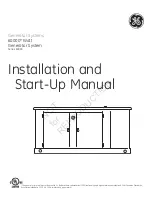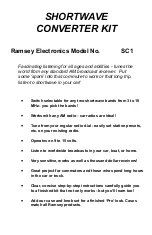
--7--
Function of the Power Control:
The charging converter is voltage-controlled or activated via the control input "D+". It will be deactivated automatically if
the engine is switched-off. It starts with minimum charging capacity.
After the engine start, also the STARTER battery shall be charged immediately and its starting capacity shall be maintained.
Therefore, the charging converter does not start charging the BOARD battery, before the voltage value "increase of the
charging capacity" of the STARTER battery is reached. See page 5.
The gradual increase of the charging capacity for the BOARD battery by the charging converter will be effected, if the
voltage value "increase of the charging capacity" of the STARTER battery is still reached and exceeded.
In case of strong load on the starter circuit due to many large consumers and the STARTER battery’s voltage drops again
below the value "reduction of the charging capacity", such as during engine idling, there will be a gradual reduction of the
charging capacity for the BOARD battery to relieve the starter circuit.
If the voltage drops below the "Switching off threshold" for 30 seconds, the charging converter will be switched-off
automatically. As soon as the voltage exceeds the threshold "increase of the charging capacity", the converter will be
switched-on, and the capacity will be increased gradually until the required (maximum) charging capacity is reached.
A reduction of the charging capacity by more than 30 % due to insufficient input voltage of the generator will be indicated
the LED "Power", which turns off shortly every 2 seconds. The LED will again light permanently, as soon as either the input
voltage is sufficient or the power requirement had dropped anyway due to a charged BOARD battery.
The automatic control of the unit ensures, that the bottleneck of the rating of the connector and the vehicle's
electric system in front of it (12 V /
max. 20 Amperes
) will not be exceeded.
The efficiency of the unit results from this aspect and is based on the physical laws. If the vehicle voltage (IN) is
high and the battery voltage (OUT) is low, the charging current to the battery can indeed exceed 20 A. In the
reverse case, it turns out lower.
Recharging Branch for STARTER Battery 12 V:
The unit is equipped with a charging branch, which ensures support charging and trickle charging of the STARTER battery
12 V in case of extended standstill periods. It will be activated automatically, as soon as the BOARD battery had been
sufficiently charged, for instance by a mains supply charger (see Technical Data "Recharging Branch"). A small part of the
charger current (approx. 0 - 1 A) is diverted from the BOARD battery for the STARTER battery.
Charging voltage and charging current are reduced, in order that an overload of the STARTER battery is excluded.
Activation of the recharging branch is
only possible with control "D+"
of the charging converter, and not with "voltage
control", described under"D+" Control Input, page 5 !
Start-up and Function Test:
After connection and setting of the charging converter, the function can be tested:
1.
Start the vehicle:
-
The charging converter will be activated (LED "Power" is on) and starts with minimum charging capacity.
2.
Increase the speed of the vehicle to increase the voltage at the STARTER battery until it exceeds the adjusted value for
the "increase of the charging capacity".
-
The charging capacity will be increased and is raised to the maximum value or to the required value of the charging
characteristic line, if the BOARD battery is already full.
Tips:
Unit does not start, the LED "Power" is not lighting:
a.
Check the voltage at the activation input terminal "D+", > 8 V.
b.
In case of pure voltage control (without D+), check the voltage rates directly at the terminals. See page 5.
High charging current is not reached:
c.
The unit protects the 13-pole connector of the trailer and of the vehicle's electric system by a limitation of the
maximum input current to the admissible value 20 A. This effect occurs mainly in case of low vehicle voltage 12.6 V
and simultaneous high charging voltage, such as 14.0 V. Also refer to
Function of the Power Control.
d.
BOARD battery is already charged: Turn on devices with high current draw.
High charging current is not reached, the LED "Power" turns off every 2 seconds:
e.
Check the voltage directly at the ter/- IN 12 V: The voltage must be higher than the
threshold "Increase of the
Charging Capacity".
Increase the engine speed, in order that the charging converter is able to regulate to a higher
voltage.
f.
Check the c/-OUT 12 V BOARD and fuse 1. Check the indicated cable cross-sections.
g.
Check the cIN 12 V START up to the trailer connector.






























